

Flights: Munich - Amsterdam; Amsterdam - Nairobi
Private homepage – Hans-Georg Michna
Kenya travel reports: 1999, 2000, 2002, 2003, 2004, 2005, 2006, 2007, 2008, 2009, 2010, 2011, 2012, 2013-Goma, 2013, 2014, 2015, 2016, 2017, 2018, 2019
Kenya Safari Travel Plan, Kenya 1980-2000 photos
Kenya 2019
A personal travel report from Kenya in May and June 2019
Last change: 2020-01-20 – Copyright © 2019-2023 Hans-Georg Michna
Click on the small pictures to see them enlarged, usually to 800 x 600 pixels.
Times are given in local Kenyan time in 24 h format (without "am" or "pm"), i.e. 0:00 to 23:59.
All photos are subject to copyright ©. If you want to reuse any photo, send me an email asking for permission, and I may send you the full-size photo, usually 3,264 x 2,448 pixels (8 Megapixels). These photos bear the copyright © 2019-2023 Hans-Georg Michna.
EXIF times in these pictures should carry proper time and time zone information. Kenya time is UTC + 3 h.
This web page is automatically reloaded with a date extension to its URL to defeat Safaricom's fraudulent proxy server.
[I still use my latest camera—a Fujifilm HS50EXR. Most photographs in this travel report are reduced to 800 x 600 pixels and JPEG-compressed with medium strength to make them more palatable for the web.]
My Kenyan phone number is +254724662096. It is good for SMS and calls, but the better ways to reach me are Signal, Telegram, Threema, WhatsApp, Hangouts, Skype, and email. For those chats that use telephone numbers as addresses, you have to use my German mobile number +491793217777.
My travelling checklist in michna.com/kenya.htm#Preparations (German version: michna.com/kenia.htm#Reisevorbereitungen) is, as always, my means of packing without fear of forgetting anything important. As usual, the packing and other preparations take at least a full day of concentrated work, because they cover an immense number of small things and details. Without the checklist I'd be lost.
KLM, Air France, and Kenya Airways on their flights to Nairobi currently allow two pieces of check-in luggage of up to 23 kg each in the economy class. KLM also has a pretty good and informative web site and a reasonably good smartphone app (click here for the Android version if you fly KLM), allowing ticket purchase, online check-in, and seat selection, now also for the flights operated by Kenya Airways and Air France.
Our flight was uneventful, nice, and ultimately on time. We enjoyed not having to get up extremely early, because the plane was supposed to leave Munich at 9:25.


Flights: Munich - Amsterdam; Amsterdam - Nairobi
We could not see very much, because most of the time it was cloudy. But we did see the river Nile in Egypt and the Sudan.
We had all the forms (visa application, immigration, and customs declaration, already filled in, so we were not very late for the lines at the counters. When we came downstairs to the luggage conveyor belt, we immediately spotted two of our suitcases and took them off.
After a short while we had all but one piece and began to worry, when one overly friendly airport official pointed out that sometimes they take some pieces off the belt to make room for more, particularly for big aeroplanes like our Boeing 747-400. So Mause went over to the other side, and there was her suitcase, as predicted.
Unfortunately the seemingly helpful guy turned out not to be really helpful after all. He kept trying to direct us here and there, grabbed pieces of our luggage, put it on a cart, directed us to the last security check, took some pieces of our luggage to push it through the scanning machine, loaded some pieces onto the cart again, and confused me so much that I ended up forgetting one of my most important bags next to the security scanner.
Fortunately I came to my senses quickly, checked the luggage, and noticed that one piece was missing. So I quickly turned back and took my bag, which was still standing there.
It was not his intention to get one of our bags. His sole intention was to appear helpful to attract a large tip, which did not work well in our case. In effect that guy was not helpful at all, quite the opposite. To me it seemed more like harrassment. Anyway, another lesson learned. My recommendation is to refuse any help that is not needed. I admit, he did help us with a piece of information to find our missing suitcase. But the bag was a much bigger deal. We would have found the suitcase anyway, sooner or later.
Porto Car Hire brought a Toyota RAV4 4-wheel-drive car to the Aero Club. I will report a little longer about our experience with this type of car below.
I had lots of little preparation tasks to do, but in the first evening we arranged a dinner party for our Nairobi friends in the Aero Club's restaurant. The party was very nice, and we chatted for much longer than I had planned.
For a few of our friends who could not come that first evening we arranged a second dinner the next evening, which was also very good.
Since I wanted to fly to Lamu, I was looking for a Cessna 172 to hire, and I found one in a flying school not far from the Aero Club. I will have to do a check flight on Saturday or Sunday, because of course they want to see whether I can fly the plane safely (and also because I have to pay for plane and instructor). So let's see how that goes.
On this Thursday we left the Aero Club one day earlier than originally planned, to return one day earlier as well. After breakfast in the club's restaurant we paid for the room (using M-Pesa) and drove out. First we drove to the Galleria mall on Langata Road, the same road that passes by Wilson Airport, and visited the big and modern Safaricom shop there. We tapped our Safaricom mobile phone numbers into an automatic receptionist and each got a paper slip with a number that was soon called out by another machine, which directed us to one of the desks. I found the well-organized shop quite impressive.
The purpose of our visit was to remove a KSh 100,000 ($1,000) limit from our M-Pesa-related savings account, "M-Shwari", which we use to have more Kenyan money available than the M-Pesa account can hold (also KSh 100,000). We did not succeed in the first attempt, because M-Shwari is not directly run by Safaricom, but by the Commercial Bank of Kenya. So our request was forwarded, and we are now awaiting a message from the bank. It is possible that they do not extend that account for foreigners like us, so we don't know what will happen. It does not matter all that much to us, but it would be an added convenience, particularly when we travel with more friends who have no Kenyan phone numbers. When we travel with a larger group, perhaps a few of the travellers may have to get Kenyan SIM cards and M-Pesa accounts. In fact, this takes only an hour or two, so we will have a solution one way or the other.
We soon left the Safaricom shop and drove back a short distance to branch off onto a new road, the Southern Bypass. The part connecting the southern parts of Nairobi to the Mombasa Road has now been finished. The Southern Bypass looks exactly like a newly built German autobahn, two lanes in each direction, center separation, repair strips. The only difference is that there is a general speed limit of 100 km/h in Kenya, only very occasionally raised to higher speeds by traffic signs. But the Southern Bypass is a blessing for us, not least because it shortens our trips from and to the international airport quite a bit and makes it more reliable.
We drove down the Mombasa Road to Emali and turned right/south towards Oloitokitok, the more or less informal capital of the Maasai lands, moving towards the magnificent Kilimanjaro mountain, whose upper parts were covered with clouds. Before we reached Oloitokitok, we turned right again and drove westerly towards Amboseli.
Most of the Mombasa Road is still two lanes with repair strips and a few uphill crawling lanes. Because of the heavy truck traffic it is difficult to reach speeds above 60 km/h and often less when it goes uphill without an extra lane. But on the road from Emali to Oloitokitok there was practically no traffic at all, so we could drive at our personal speed limit of 80 km/h. The last bit to AA Lodge is unpaved and occasionally corrugated, so we are happy when we can drive 40 km/h.
Total averages, not counting stops: 243 km, 4:45 h, 51 km/h.
In one place we stopped, beause there was a large congregation of Maasai giraffes (that's the common species name), almost 20 of them in close proximity. The situation and the light was not good enough for photos.
We stopped at the Amboseli Sopa Lodge, formerly Kilimanjaro Buffalo Lodge, and inquired about prices. They were a bit more expensive than the AA Lodge and not quite so nice, so we carried on and ended up in the AA Lodge, short of the Amboseli entrance gate. We do this to reduce the Amboseli entrance fees that are paid for exactly every 24 hours inside the nature reserve. They are as expensive as a night in the lodge, so it saves money to plan the time well.
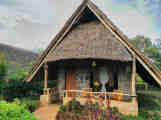
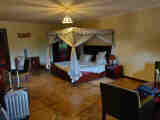
Our room in the AA Lodge, outside and inside
The AA Lodge is huge and at this time of the year almost empty. Its restaurant is good, the rooms are spacious and pleasant, and we can relax a bit before travelling on. And continue to write this travel report.
We drove around near the swamp and small lakes and met various birds.
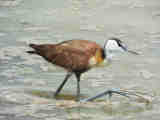
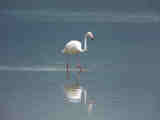
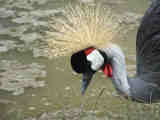
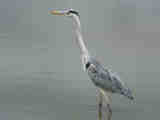
A small lake has formed along the track leading to Ol Tukai Lodge. Birds like
it.,
Hyaenas and warthogs have developed a symbiotic relationship.
I had never known this and learned it only today from the elephant researchers, whom we met in the evening for dinner in the lodge.,
We set out for Nairobi in the morning, because I wanted to do a checkout flight with a flying instructor at 3 pm. However, the weather was rainy, so they cancelled it for now. Next chance on Friday.
When we left the lodge compound, six young lions walked on our side. Their parents were not there.
We reached Nairobi as planned and changed our plans by shifting our Masai Mara trip to one day earlier, tomorrow.
After inquiring about my farorite route to the Fig Tree Camp in Masai Mara via Aitong and finding out that it is currently not blocked by water, we left Nairobi at 9:00 and quickly reached Mai Mahiu and Narok, where we filled our tank, asked again, and got the same answer, drivable, no water.
So we continued, but found that the normal turn-off was blocked by a sign saying that the road is being worked on. So we continued on the main road and asked Google Maps for directions. That did not work well. Google simply does not know the small roads.
So we asked several people in the next town how to get to Aitong and received a consistend answer—go back, cross the river (a small bridge over a small river), and take the next right.
This was correct, but it was a long, slow, bumpy ride over a stony track that went on and on parallel to the track we had driven in the years before, separated from it by hills. But eventually we could cross over and continue on our normal way.
The track soon got much better, and we drove most of the rémaining 40 km at speeds of 50 to 70 km/h.
In no time we reached the small village of Talek and turned right towards the lodge. The track I had usually taken from this direction was blocked by fences. Apparently somebody was now enforcing ownership. We took the other way a bit further down the road and entered the lodge compound, where everybody recognized and greeted us.
After a small dinner we went to bed early.
I slept for 10 hours. Both of us had caught a cold during the last few days, so this was good. I think the warm, very pleasant climate will help us to recover quickly.
In the afternoon I drove around a bit on the northern side of Talek River. I saw quite a few eland.
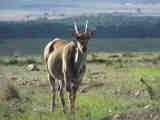
Common eland (Taurotragus oryx)
There were lots of other large animals as well, many antelopes and gazelles.
We are both still sick, Mausi more than me, so please do not exect too much for this travel report until we recover fully.
After breakfast we finally drove across the bridge over Talek river into the main area of Masai Mara. To my surprise the gatekeeper demanded US dollars. The last time I was here, I could pay in Kenya Shillings via M-Pesa.
Since I had just sold my last US$ in Nairobi, happy to get rid of them, the only alternative they offered was to pay the entrance fee in Kenya Shillings in cash for an extortionate rate 10% above the market rate. They did not accept euros either, even though a large part of their clientele hails from Europe. And, to my complete surprise, they seem to be the only people in Kenya who do not accept an M-Pesa payment. In Kenya you are never quite safe from such surprises when you have to deal with local governments or the national one. The rules keep changing and are inconsistent throughout the country. Fortunately there are usually ways to muddle through.
We continued on a late morning drive and saw hippos, zebras and other animals.
Back in the camp we found a baby crocodile, perhaps 1 m long, on the stones in the river directly in front of our tent.
In the afternoon we drove out again and saw a lot of animals, but again the sun disappeared behind a cloud cover, making photography difficult.
Among buffalos and eland we saw a few hyaenas. This one was lying in the grass directly next to our car and only temporarily raised its head.
Mausi was still sick and decided she willl avoid the drive to Nairobi. So she hopped on the next flight (Safarilink) and flew in one of the very common Cessna Caravan aeroplanes back to Nairobi. I drove her to Ol Kiombo airfield and, on my way back, drove slowly along the river Talek on its northern side.

Mostly wildebest, also zebra and topi
In the afternoon I drove out again and caught a sunny period to take this photo:
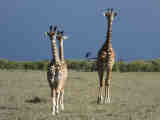
Maasai giraffe mother with her two children
I got up early to be sure to leave the nature reserve before the last 24 hour period expires at 10:00. I wanted to try the other, classic, route back to Nairobi via the Sekenani Gate. I left around 7:30 and reached the gate already around 8:30, because nothing happened on the drive. I marvelled at the wonderful landscape along my way.
The next hour and a half I had to drive on the known, gruelling, stony, and dusty road. Since the wind came from the right, each car that came towards me left me in a cloud of dust. Fortunately, the car's filters did a good job keeping the dust out, but they must be pretty clogged by now.
Sometimes I tried driving over to the right side and stopping when there was opposing traffic, but this method fails when there is too much traffic.
Then I suddenly drove on a new stretch of paved road, best quality and fairly wide. For half an hour I could enjoy driving 80 km/h. I think it is unfair that the good parts of the road can be used only for a much shorter time.
The last bits of the road were partly unpaved again, partly they were still the old, paved road from times immemorial.
In Narok I drove into a workshop to be able to look underneath the car, because I heard some resonating noise at low rpm, more or less at idling speed. Apparently a rubber part had got lost that normally carries the exhaust. In Narok you can get all kinds of spare parts, at least for Toyota cars. Another light bulb had also blown, so they put in new light bulbs.
Of course, this being Kenya, you can never know whether somebody dived under the car quickly and removed a part, only to sell it back to you the next moment. But altogether it did not cost too much, and the problem noise was clearly gone, so I will call this quick repair a success.
The rest of the trip was uneventful, apart from a complete traffic jam at the entrance of Wilson Airport, probably due to some politician departing or arriving. I quickly changed to an alternative entrance, thanks to Google Navigation, and could get in quickly. I arrived in the Aero Club of East Africa just after 15:00.
Mausi was clealy on track to recovery. She did not feel much better yet, but at least she no longer felt the need to swallow Aspirin pills.

Map of the trip to Nakuru, Baringo, Samburu
We checked out and then had lunch with one of our Nairobi friends before leaving at 14:30. The receptionist of the Aero Club came with us. She had finished her work and wanted to visit her relatives in Nakuru. When she heard that we were going to Nakuru, she asked us for a ride, which we gladly provided.
First we entered the Southern Bypass, not far from the Aero Club, and soon we joined the main road artery of Kenya, the A104, to Nakuru.
The average speed is low, because much of the road has only two lanes with the occasional climbing lane. Truck traffic makes it impossible to drive fast. Overtaking is difficult and in most places impossible. But it is not very far, so the drive took only 3.5 h, and we arrived at 18:00, well before dark, after driving through some pretty heavy rain.
We just left the rain behind and arrived at the Nuru Palace Hotel in dry weather. We quickly moved into our room (#20, in Wi-Fi range) and then back into the restaurant to meet with our friend Sue, who had already come there to have an early dinner with us.
The food and drinks were OK. We chatted for a while, then said goodbye and went back into our room.
We were not happy with the room, because practically nothing really worked. We made a mental note to look at some other hotels the next time and fell asleep.
After a fairly good breakfast we left Nakuru northward towards Baringo. Along the way we had to cross the equator, and nearby lies the 36° East meridian, in the middle of a sisal plantation. That is the place I had defined as a virtual geocache a long time ago. This time we had a well prepared signpost with us, which we wanted to position exactly at the confluence of the equator and the meridian. So we drove off the road onto a smaller track that leads into the plantation.
The virtual geocache lies exactly on the eastern side of a small canal, which cuts through the plantation. We determined the exact position, which is on a small dam next to the canal, and rammed the signpost deeply into the ground, hoping that it will stay there at least for a few years.
On average, about one person or group visits this place every year, but this geocache has meanwhile gained some notoriety among the insiders, because of its unique properties. It is one of the earliest geocaches on our planet and apparently the very first that had been put on the equator. And the meridian that runs through it makes it doubly unique.
After this task we continued our journey north. During the geocache operations we had crossed the equator 9 times, not to mention even more while dancing around the cache.
We arrived in Baringo around noon, after staring at the car's outside air thermometer while driving, which climbed degree by degree, ending at 32°C. The people there told us, ah, that's still cool. We have had 40°C a while ago. Indeed, I found the temperature not too bad after all. The air was not too moist, and if I don't have to do any marches in the searing sun, I can survive.
We had a nice lunch in the Thirsty Goat, the restaurant of Roberts Camp, where we intended to stay. Through the hottest part of the day in the afternoon we just rested. Our room, a round hut with toilet and shower, also had a fan, which I used to cool myself down when I thought it was too hot.
We went around on Lake Baringo on a boat and took some photos. First the drowned lodge, which is decaying year after year.
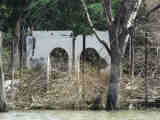
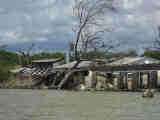
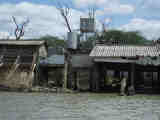
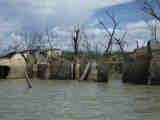

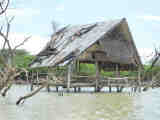
Lake Baringo Lodge ruins; Hammerkop House ruin of Roberts Camp
Lake Baringo and its surroundings are home to over 500 bird species. There are several species of cormorant here, the largest being the African darter. And there are several species of kingfishers, a few of which are shown below.
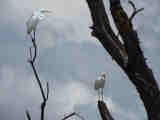
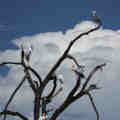
Egret and stork; birds on a tree
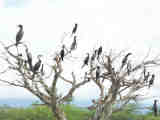
Various cormorants and other birds
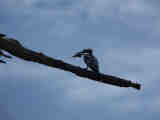
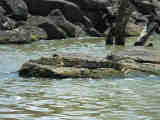
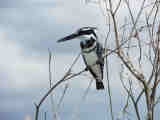
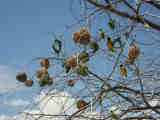
Kingfisher with fish;
Nile crocodile; kingfisher; weaver bird colony
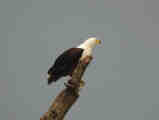
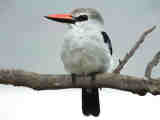
Fish eagle (deutsch: Schreiseeadler); kingfisher
When it got dark, we saw hippos come out of the lake onto the campground grass. We saw two large owls silently fly above our heads. And there are glowworms.
It has rained every night while we were here. Given that Baringo sometimes does not get any rain for two years, this looks a bit unusual. More rain is the likely cause of the rising lake water level, which drowned the lodge and part of Roberts Camp a couple of years ago.
Perhaps due to the rain, on 2019-06-02 communications failed completely during the afternoon. Since the camp's Wi-Fi relies on the same mobile connection, it also had no internet connection.
We started early and drove out of Baringo at 7:00. Because of the rain we could not risk taking our favorite northern route and instead drove back to Nakuru, then to Nyahururu, where we had breakfast in the Falls Hippo Point restaurant.
The restaurant had open-air seating with sun roofs, but in the cool morning we went indoors into a darkish room with many empty tables and a television set that we muted to avoid the noise.
They had a good variety of foods for relatively low prices. We had our breakfast and left to drive the still long distance.
The landscape around Nyahururu is impressive. The road snakes high over the outskirts of the Aberdare mountain range with views over the whole landscape of central Kenya. Soon we saw Mount Kenya in front of us.
Google recommended a significant shortcut from the B5 to Naro Moru on the A2. We drove to the turn-off and asked some matatu (private minibus) drivers, and they confirmed that this was the best road there. So we turned onto the smooth, paved road, hoping to save quite a bit of time.
We did indeed save a bit of time, but by far not as much as we had hoped, because we forgot to ask whether the road is completely paved. It turned out that the paved part ended soon and changed first into a muddy side road next to a road-building project, then into what is called the Nyahururu-Naro Moru Murram Road, murram being a local word for gravel. I could only drive very slowly on that, hardly ever above 15 km/h, so it took quite some time.
Luckily the last few kilometers were again paved. Anyway, I made a mental note to always ask whether a road is completely paved or at least smooth enough for some speed. It still looks as if driving only on paved roads would require to drive all the way south to near Nyeri on the B5, then all the way north to Naro Moru and Nanyuki again on the A2. All shortcuts are apparently unpaved, rough roads.
We reached Naro Moru and quickly, at 14:30, reached one of our favorite restaurants in Kenya, Barney's Bar & Restaurant, on Nanyuki Civil Airport. We had a leisurely lunch in their open-air part of the restaurant. To be realistic, the menu said pepper steak, and what I got was steak with chili sauce. But such lapses are not uncommon in Kenya.
It turned out, however, that our two restaurant stops took too much time. We still had to drive through Nanyuki, across the foothills of Mt. Kenya, down into the flatlands, through Isiolo, and branch off from the fast road to Ngaremara Gate, the entrance to Buffalo Springs. That last bit had water and mud holes.
We passed the gate, paid our entrance fees, and continued inside the nature reserve. There the tracks were in large parts blocked by heaps of road-building material, forcing us to drive on side tracks and again dealing with mud holes.
Eventually we crossed the bridge over the Samburu River, also called Ewaso Ngiro, but that name is meaningless, as many rivers in Kenya bear that same designation.
We only barely made it to the lodge before it got dark, again driving around and through some mud holes. Driving on (mostly) paved roads is no guarantee to make it in time. The points to remember are, if there has been rain in the last couple of days, avoid Buffalo Spings and drive through Archer's Gate instead. And, don't waste two long stops on restaurants.
The river looked wild, had high water and high standing waves. You could probably do some surfing on the stationary waves, if you weren't afraid of the crocodiles. The rains further up the highlands have been filling up the river. But despite the fast-flowing current one crocodile found its way to the feeding place at the lodge.
We slept long and had a late breakfast at 8:30. There had been no rain since we were here. The lodge was nearly empty. We met a few French-speaking Canadians.
In the evening I drove out and found a group of four giraffes, which I documented for the research project, i.e. I took the GPS coordinates and identifying photos. I also saw a fairly big tortoise:
In the evening we sat in the bar on the riverside and saw bats hanging from the thatched roof.
These are some photos from a late morning drive.
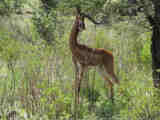
Male gerenuk (deutsch: Giraffengazelle)
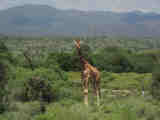

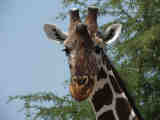
Reticulated giraffe (deutsch: Netzgiraffe)
The reticulated giraffe is a hallmark of the Samburu area. It is one of the three species of giraffe in Kenya, and Kenya is the only African country that has more than one giraffe species.
This is the home of the Samburu Seven, species you can see nowhere else: reticulated giraffe, Grevy zebra, Beisa oryx, gerenuk, desert warthog, somali ostrich, and the vulturine Guinea fowl. We have seen them all this time, but could not always take photos.
We decided to do another not too long drive before it got dark and drove a little farther in a northeasterly direction. We met quite a few elephants and could observe this scene of two young elephants drinking from a puddle next to a safari car. Consider that these are completely wild animals, just a bit habituated and used to tourist cars.
As it turned out, driving at this time and in this direction was an outstanding idea. We first saw 14 giraffes and took identifying photos, though not good enough to show around, and their GPS position. We also saw these animals:
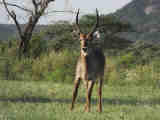

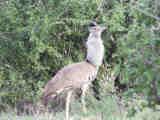
Waterbuck; bee eater; Cory bustard (deutsch: Riesentrappe)
While observing the giraffes, we noticed some large, grey animals among them. Sure enough, these were the elusive Grevy zebras.
But before we got close, another animal passed in front, and this was a real surprise—a striped hyaena.
This is a rare, nocturnal predator, one of the four hyaena species still in existence. Its state is "nearly threatened", as there are only about 10,000 still in existence in northern and eastern Africa, the Middle East, and Asia.
Normally striped hyaenas are strictly nocturnal, leave their den only when it is completely dark, and return to it before dawn. But this one had something urgent to do, and so I could take these photos.
After following the striped hyaena for a while, we eventually lost it and returned to the Grevy zebras.
I find this zebra species very beautiful and impressive. After taking the photo, we soon had to leave them, as it was already getting dark, and we still had to drive back to our lodge.
Before having dinner we watched these guys, who were waiting for a few bones from the kitchen.
We drove out the West Gate in the morning and visited the Ewasolions project.
When we returned in the evening, we saw 21 giraffes in one large congregation and tried to document them all, which was difficult. I cannot remember having ever seen so many giraffes in one place. It was already getting dark, so no photos.
We did an early morning drive and watched two leopards for a while. They were difficult to see and impossible to photograph, so, again, no photos. But they looked so beautiful!
After breakfast I went to the car mechanic in the lodge and asked him to check a metal plate under the engine that protects the underside, but had come loose and tended to scratch on the ground. We bent it back a little into proper shape and attached it as well as possible. Now the car behaves much more nicely on rough ground.
Almost at lunch time we received hints about the positions of one female cheetah and a lion, so we drove out again to find them. But when we arrived at the cheetah's position, a group of elephants had marched into the area, and the cheetah had probably gone into hiding. We could not find her.
When we drove on to find at least the lion, we met a herd of oryx antelopes, along with a few Grevy zebras, not to mention some yellow-necked spurfowls and several Grant's gazelles.
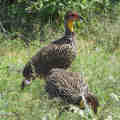
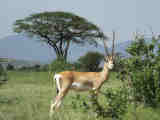

Yellow-necked spurfowl; Grant's gazelle; Beisa oryx antelopes
We didn't find the lion and barely made it back in time for lunch, but still got something nice to eat.
In the afternoon clouds appeared and there was even a short rain shower, so we stayed in the lodge, because of the poor ligthting conditions for photography.
In the evening we went to the dinner area, and I almost stumbled over a snake that was crossing my path. I first thought that it was a young python, but closer inspection revealed that it was a puff adder, a highly poisonous, but fortunately slow-moving, snake that is responsible for many snake bites in Africa.
I told the lodge crew about the snake to reduce the risk to other guests. They ushered us away and later told us that the snake had gone. We will never find out what really happened.
After dinner I saw another bat, apparently a different species, compared to the one I had photographed earlier. Also, the same big crocodile, apparently a regular at the lodge, had appeared again.
I woke up early and drove out. The weather was the opposite of what was forecast, completely overcast with periodic light rain. I thought of turning back, but then continued, which turned out to be a good idea, because I met a leopard. First he was lying in a dead tree, but then he came down and wandered about.
How can these animals be so stunningly beautiful?
Later in the morning we walked along the lodge's river bank. The lodge is almost 600 m long. On the eastern side we saw two crocodiles on the other side of the river.
In the afternoon at around 16:00 we drove out in spite of the poor lighting conditions under an overcast sky and, among many elephants and giraffes, found these animals:
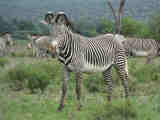
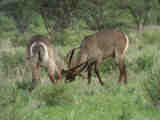
Grevy zebra; sparring waterbucks
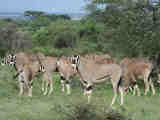
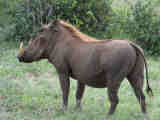
Beisa oryx antelope; desert warthog
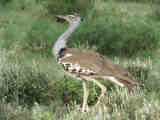
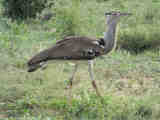
Cory bustard (deutsch: Riesentrappe)
We did a short drive from 12:00 to 13:00 next to the lodge. I took photos of dikdiks, which are a bit shy and hence difficult to photograph. They are tiny gazelles, one of the species that do not need to drink from the normal water sources. They lick dew and probably also use water contained in their food.
Another quite common antelope species is the impala. Here they were standing in the shade to avoid the heat of the intense sun at noon. Note the impala kindergarten in the middle of the group.
Later we did a lengthy evening drive to look for lions that had been reported in a remote place on the other side of the river, in the Buffalo Springs Reserve. So we crossed the bridge and drove a lot, but the lions were nowhere to be seen. Still we saw a lot of giraffes and also took these photos:
I did two short drives, one around noon and one in the evening. Here are some photos.
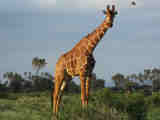

Reticulated giraffe with birds; Samburu landscape with elephants
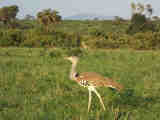
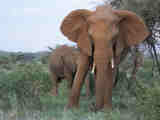
Cory bustard (deutsch: Riesentrappe); elephant mother and child
Currently there are many elephants and giraffes in the nature reserve. Several times elephants were blocking my way, so I either had to wait until they moved away at least a few meters or I had to go back and take another way. Fortunately almost all of the elephants were very relaxed and did not react negatively at all. Only once this year I had met an older elephant cow who reacted nervously (raising trunk to sniff, shaking head).
Although we drove around, the only photo I'll keep was made from inside the lodge compound.
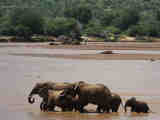
Elephants crossing the river next to Samburu Lodge
On our last day in Samburu we drove to the eastern side of the nature reserve and took these photos:
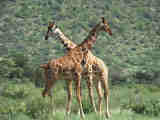
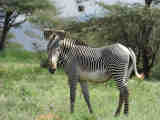
Reticulated giraffre; Grevy zebra
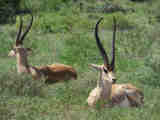
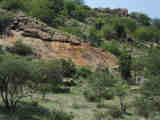
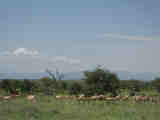
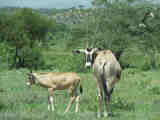
Grant's gazelle; landscape with Beisa oryx antelope; congregation of Grant's
gazelles; oryx antelope with young
We rose at 6:00, had a quick breakfast from 6:30 to 7:00, and drove to Nairobi via Archer's Post and Nyeri, where we had a quick lunch in Betty's Place, one of the few restaurants where one can pay with bitcoin.
We reached Nairobi around 16:00, indicating that we might have left Samburu an hour later without being too late. Perhaps next time …
After unpacking we went straight to the Aero Club's bar.
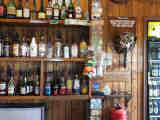
The bar in the Aero Club of East Africa (detail)
Our flight back home was timed at 8:30. We woke up a bit before 5:00 and had our taxi ready at 5:30. The drive to the airport, still in the dark, was fast, because at that time there was hardly any traffic.
We had to go through 4 security checks and narrowly escaped a 5th one at the gate, where some passengers were rechecked.
The two flights were done by Air France. We flew the first part from Nairobi to Paris CDG (Charles de Gaulle) in a new Boeing 787-9. I think this was my first of these long-distance flights where the toilet in the plane really worked. I could wash my hands without having to keep pushing a button with one hand to rinse the other. This tap had a sensor.
The other admirable feature was the entertainment system with a big screen in the backrest in front of me with a good flight information system and a lot of movies. It even had a cockpit view with a display like that in a modern aeroplane dashboard with large computer screens instead of the old, round instruments, but unlike the pilot's screen, which only shows an artificial horizon, this one showed a satellite map of the earth in front of us.
As usual we could see the river Nile on our right side, the Mediterranean Sea, the Alps, etc. The flights were easy and enjoyable.

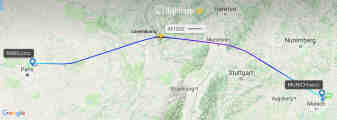
The flights: Nairobi - Paris CDG; Paris CDG - Munich
We arrived in good shape and noticed that at this time of this year the temperatures in Germany were not unlike those in Kenya.
We have used the Toyota RAV4 4-wheel-drive already a few times in Kenya, but it is clearly less than ideal for the purpose of off-road driving in the typical nature reserves like Samburu and Masai Mara. First of all you have to be aware that there are several versions of this type, even a two-wheel-drive that is front-wheel-driven. Never use this one, because you will always get stuck and sand and in other difficult situations.
These cars usually have no roof hatch or sun roof. They do, however, have an excellent, continuous automatic transmission and also excellent air conditioning. The car also has a very good, soft suspension that allows to drive relatively fast on moderately rough roads. (Of course you can drive fast on smooth roads with any car, and you have to drive slowly with any car on seriously rough ground.) Another advantage is that it can be hired quite cheaply. We paid US$ 55 per day on this trip. Other, even not much bigger cars can easily cost three to four times as much.
On the minus side, the main problem is insufficient ground clearance. The design of the underside is also problematic. A protective metal shield under the engine is fastened with four bolts. The front two bolts are recessed. The metal shield has a step, so these two bolts are well protected and survive frequent ground contact. The rear two bolts, however, protrude under the metal shield and are usually already sheared off, so the shield dangles and scratches loudly even on relatively flat underground. These bolts are difficult to replace. A proper repair would probably involve welding. So in most cases wires are used to tie up the shield. The wires, however, are sheared off much sooner than the bolts were originally, so this is a continuous problem, requiring repeated emergency fixes.
The lack of ground clearance requires a continuous effort by the driver to avoid ground contact by driving on the side slope of the grooves created by other cars that usually have a higher ground clearance. Ground contact cannot always be avoided. Depending on the sunlight or its absence the depth of the grooves is sometimes difficult to estimate or stones and other obstacles in the middle are overlooked or their height not estimated correctly, leading to bad ground contact.
The car is also wider than needed for, say, a two-person safari, so it collects more scratches from bushes and trees on the side than necessary. This, however, can hardly be avoided, because most alternative car types are at least as wide.
I will think twice before using the Toyota RAV4 again on such a trip, particularly in Samburu. I cannot recommend it.
If in this text you find any typos, orthographic errors (even small ones), ungrammatical sentences, wrong or illogical information (like wrong names of birds), if you want me to write more details about something in particular, or if you want one of the photos in full resolution, please click on the email sign below and write to me. Many thanks!
Copyright © 2019-2023 Hans-Georg Michna.
Private homepage – Hans-Georg Michna
Kenya travel reports: 1999, 2000, 2002, 2003, 2004, 2005, 2006, 2007, 2008, 2009, 2010, 2011, 2012, 2013-Goma, 2013, 2014, 2015, 2016, 2017, 2018, 2019
Kenya Safari Travel Plan, Kenya 1980-2000 photos
hits since 2019-05-13
Free PHP scripts by PHPJunkYard.com